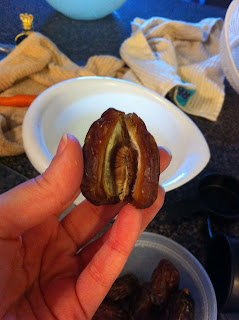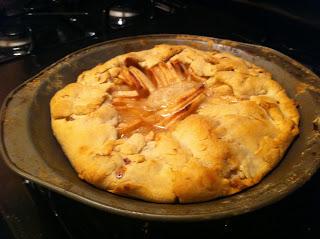It's been really hard for me to determine what to do with the carrots I have. I didn't want to just make some candied carrots as a side.
It hit me that I don't recall ever making carrot cake, though I love it. Instead of going for a full-on cake though, I thought I'd try a loaf. I added some Medjool dates that I had delivered to my house, along with some currants and coconut flakes.
What you'll need:
1 cup of shredded carrots (about 1/3 pound, or 3 large carrots)
1/3 cup Medjool dates, pitted and chopped
1/3 cup Zante currants
1/3 cup shredded coconut
warm water
2 cups flour
3/4 cup sugar
3 eggs
1 tablespoon baking powder
1 1/2 teaspoons cinnamon
3 tablespoons canola oil
canola spray
For gluten-free people, I found a similar recipe on Whole Foods' website for carrot and date muffins that uses a blend of almond and either amaranth or millet flour. I'd imagine that would work with this recipe too, 1/2 a cup of almond flour and 1/2 a cup of either amaranth or millet.
Preheat your oven to 350 degrees.
First, pit and chop the dates. a cut down the middle with a knife should let you peel the date back from the pit.
Add the chopped dates to a bowl with the currants. Cover them with warm water to help reconstitute the dried fruit.
Then shred up your carrots. I did it using a plain old grater.
Crack your eggs in a bowl. Adding eggs first will help if you accidentally get a piece of shell in there. Then add the canola oil and carrots.
In a larger bowl, add the flour, sugar, baking powder and cinnamon. Blend until all ingredients are thoroughly mixed. Then add the coconut and blend again.
Then add the ingredients from the carrot bowl into the dry ingredient bowl. Drain the dates and currants and add them to the bowl as well. Blend all the ingredients until you can no longer see any white flour and everything is evenly incorporated.
Then I sprayed a 9-inch bread pan with canola oil and poured the very dense mixture into it. I baked it for and hour, when I could pull out a toothpick cleanly.
Turns out, the dates are actually the stars of this bread, not the carrots. They're so sweet and add a lot of texture to the dish too. It's pretty dense, like it was as a batter. Perhaps if I wanted to lighten it up next time I'd add more oil or some apple sauce.
But the great thing about this bread is it is the perfect amount of sweet to be either a breakfast toast with some butter on it or a dessert by icing it with cream cheese frosting.



































